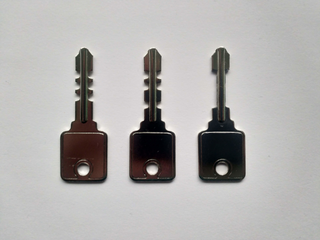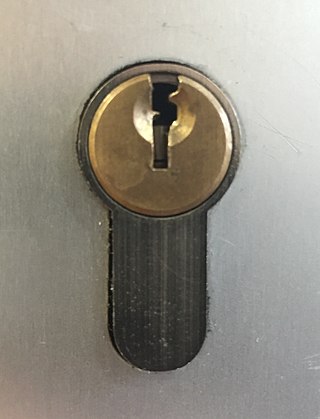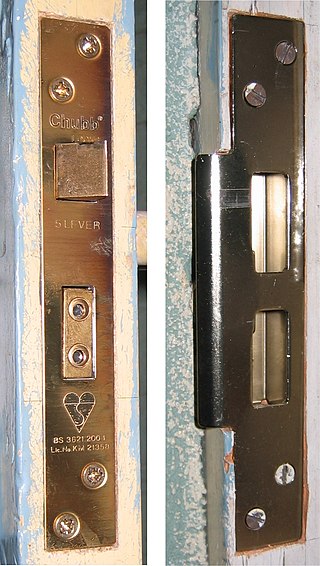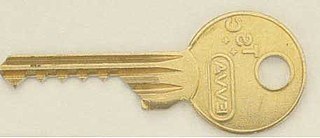
The Bramah lock was created by Joseph Bramah in 1784. The lock employed the first known high-security design.

The Bramah lock was created by Joseph Bramah in 1784. The lock employed the first known high-security design.
After attending some lectures on technical aspects of locks, Bramah designed a lock of his own, receiving a patent for it in 1784. In the same year he started the Bramah Locks company at 124 Piccadilly, London. [1]
The locks produced by his company were famed for their resistance to lock picking and tampering, and the company famously had a "challenge lock" displayed in the window of their London shop from 1790, mounted on a board containing the inscription:
The artist who can make an instrument that will pick or open this lock shall receive 200 guineas the moment it is produced. [2] [3]

The challenge stood for over 67 years until, at the Great Exhibition of 1851, the American locksmith Alfred Charles Hobbs was able to open the lock and, following some argument about the circumstances under which he had opened it, was awarded the prize. Hobbs' attempt required about 51 hours, spread over 16 days. [4]
The Challenge Lock is in the Science Museum in London. An examination of the lock shows that it has been rebuilt since Hobbs picked it. Originally it had 18 iron slides and 1 central spring; it now has 13 steel slides, each with its own spring. [5]
Bramah received a second patent for a lock design in 1798. [6]
The Bramah lock used a cylindrical key and keyhole, as does the current lock. The end of the key has a number of slots of different depths which, when inserted into the lock and pressed against spring tension, would depress a number of wafers to a specified depth and enable the key to turn and open the lock. The original shared some similarities with a modern tubular pin tumbler lock, but used fixed wafers instead of two-part pins. The original Bramah lock had 18 different wafers, which allowed for 470 million possible permutations. [2]
The lock's innovative design presented a unique engineering challenge to create tools capable of making the different parts involved. Bramah worked extensively with an engineer named Henry Maudslay to create a number of different machine tools for working with the cylindrical key and lock. [7]
The Bramah company is currently based in Fitzrovia, London and Romford, Essex. [4] Though no longer thought to be completely unpickable, the venerable design is still sold as a very secure lock. [8]

Locksmithing is the science and art of making and defeating locks. Locksmithing is a traditional trade and in many countries requires completion of an apprenticeship. The level of formal education legally required varies from country to country from none at all, to a simple training certificate awarded by an employer, to a full diploma from an engineering college, in addition to time spent working as an apprentice.

Lock picking is the practice of unlocking a lock by manipulating the components of the lock device without the original key.

A warded lock is a type of lock that uses a set of obstructions, or wards, to prevent the lock from opening unless the correct key is inserted. The correct key has notches or slots corresponding to the obstructions in the lock, allowing it to rotate freely inside the lock.

Linus Yale Jr. was an American mechanical engineer, manufacturer, and co-founder with millionaire Henry R. Towne of the Yale Lock Company, which became the premier manufacturer of locks in the United States. He was the country's leading expert on bank locks and its most important maker. By the early 20th century, about three-quarter of all banks in America used his bank locks. He is best remembered for his inventions of locks, especially the cylinder lock, and his basic lock design is still widely distributed today, and constitutes a majority of personal locks and safes.

The pin tumbler lock, also known as the Yale lock after the inventor of the modern version, is a lock mechanism that uses pins of varying lengths to prevent the lock from opening without the correct key.

A disc tumbler or disc detainer lock is a lock composed of slotted rotating detainer discs. The lock was invented by Finnish founder of Abloy, Emil Henriksson (1886–1959) in 1907 and first manufactured under the Abloy brand in 1918.

A lock is a mechanical or electronic fastening device that is released by a physical object, by supplying secret information, by a combination thereof, or it may only be able to be opened from one side, such as a door chain.

A lever tumbler lock is a type of lock that uses a set of levers to prevent the bolt from moving in the lock. In the simplest form of these, lifting the tumbler above a certain height will allow the bolt to slide past.

A Chubb detector lock is a lever tumbler lock with an integral security feature, a re-locking device, which frustrates unauthorised access attempts and indicates to the lock's owner that it has been interfered with. When someone tries to pick the lock or to open it using the wrong key, the lock is designed to jam in a locked state until either a special regulator key or the original key is inserted and turned in a different direction. This alerts the owner to the fact that the lock has been tampered with.

A mortise lock is a lock that requires a pocket—the mortise—to be cut into the edge of the door or piece of furniture into which the lock is to be fitted. In most parts of the world, mortise locks are found on older buildings constructed before the advent of bored cylindrical locks, but they have recently become more common in commercial and upmarket residential construction in the United States. The design is widely used in domestic properties of all vintages in Europe.

Joseph Bramah was an English inventor and locksmith. He is best known for having improved the flush toilet and inventing the hydraulic press. Along with William Armstrong, 1st Baron Armstrong, he can be considered one of the two fathers of hydraulic engineering.

Padlocks are portable locks usually with a shackle that may be passed through an opening to prevent use, theft, vandalism or harm.

Alfred Charles Hobbs was an American locksmith and inventor. He was born in Boston, Massachusetts, in 1812; his father was a carpenter. He married Charlotte F. Nye (1815-?) of Sandwich, Massachusetts, in 1835 and had four children: Charlotte Hobbs, Alfred J. Hobbs (1843-?), Mary H. Hobbs, and Arthur Hobbs. Both of his parents were born in England.
Rekeying a lock is replacing the old lock pins with new lock pins.

Lock bumping is a lock picking technique for opening a pin tumbler lock using a specially crafted bump key, rapping key or 999 key. A bump key must correspond to the target lock in order to function correctly.

A wafer tumbler lock is a type of lock that uses a set of flat wafers to prevent the lock from opening unless the correct key is inserted. This type of lock is similar to the pin tumbler lock and works on a similar principle. However, unlike the pin tumbler lock, where each pin consists of two or more pieces, each wafer in the lock is a single piece. The wafer tumbler lock is often incorrectly referred to as a disc tumbler lock, which uses an entirely different mechanism.

A snap gun, also known as lock pick gun, pick gun, or electric lock pick, is a tool that can be used to open a mechanical pin tumbler lock without using the key. A thin steel blade, similar in shape to a lock pick, is inserted into the lock and the snap gun briefly fires the blade against all of the lock pins simultaneously, momentarily freeing the cylinder and enabling it to be turned using a tension wrench. The snap gun is an alternative to a conventional lockpick, which requires other techniques such as raking to free the pins.
The term protector lock has referred to two unrelated lock designs, one invented in the 1850s by Alfred Hobbs, the other in 1874 by Theodor Kromer.

A magnetic keyed lock or magnetic-coded lock is a locking mechanism whereby the key utilizes magnets as part of the locking and unlocking mechanism. Magnetic-coded locks encompass knob locks, cylinder locks, lever locks, and deadbolt locks as well as applications in other security devices.
This is a glossary of locksmithing terms.